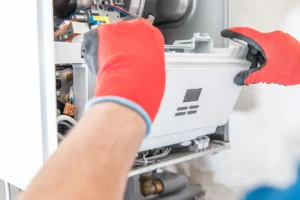If you’ve noticed your furnace leaking water, it’s easy to worry something’s seriously wrong. In reality, most leaks come down to a few common issues—things like condensation buildup, blocked drain lines, or a faulty part. At Sub Zero Temp Control, we’ve helped plenty of homeowners track down these leaks before they cause major damage to the system or the space around it. The key is figuring out why it’s happening before it leads to bigger problems like rust, mold, or system damage.
What It Means When You Find Your Furnace Leaking Water
When you find your furnace leaking water, it doesn’t always mean there’s a major breakdown. Most of the time, it’s related to condensation, clogged drain lines, or humidifier malfunctions.
If you have a high-efficiency furnace, water is a normal part of its operation. These systems extract extra heat from exhaust gases, and that process creates condensation. Normally, that moisture drains away through tubing—but if the drain line clogs or cracks, water starts pooling around your furnace.
For older, standard-efficiency models, any sign of water is more concerning. They aren’t designed to create condensation, so leaks often mean a malfunctioning flue pipe or an internal heat exchanger issue. (Trust me, I’ve seen what happens when people ignore that—it’s never pretty.)
Common Causes of a Furnace Leaking Water
Let’s break down the most frequent culprits we find in the field.
1. Condensate Line Blockages
When the small PVC line that carries water away from your furnace gets blocked by dirt or debris, condensation backs up. The result? You see water under or around the unit. It’s a quick fix for a professional, but if left alone, it can lead to corrosion and even electrical shorts.
2. Damaged Drain Pan or Hose
If the drain pan under your furnace cracks—or the attached drain hose comes loose—you’ll end up with leaks every time the furnace runs. This is one of those “looks worse than it is” situations, but it’s still best to fix it fast.
3. Internal Humidifier Leaks
Many homes have whole-house humidifiers connected to the furnace. These can develop leaks from worn seals or faulty valves, sending water straight into or under the unit. (I’ve opened panels to find mini waterfalls in there—it’s wild how much water those can push.)
4. Broken Condensate Pump
In some setups, a condensate pump removes water instead of relying on gravity. When that pump fails, you’ll often see pooling water around the base of your furnace. If you’re not sure how that small device works, read our guide, Furnace Condensate Pump: What It Does and Why It Matters — it breaks down why this part is so crucial for proper drainage and system safety.
For more on condensate pump care, the U.S. Department of Energy offers guidance on maintaining high-efficiency heating systems.
How to Prevent a Furnace Leaking Water
If you’d like a clear breakdown of what full professional tune-ups include, our HVAC maintenance expert guide is a great place to start.
Preventing leaks comes down to regular maintenance. Here’s what we recommend at Sub Zero Temp Control:
Have your furnace inspected annually. Catching small issues like clogs early prevents damage later.
Keep the area clean. Dust and debris can block the condensate drain or cause sensors to malfunction.
Check for visible damage. If you see rust, cracks, or water stains, don’t wait—schedule a service call.
Replace filters regularly. Restricted airflow can cause uneven condensation buildup.
Even simple upkeep, like replacing your air filter every one to three months (depending on your system and home), can prevent moisture issues.
For a seasonal reference, ENERGY STAR’s home maintenance checklist provides great reminders on what to inspect before heating season begins.
When to Call a Professional
If your furnace continues leaking water after cleaning the drain line or checking the humidifier, it’s time to call in a professional. At Sub Zero Temp Control, we don’t just clean up the mess—we find out why it’s leaking. Sometimes it’s a clogged line, but other times the problem runs deeper, like a damaged heat exchanger. That part can lead to leaks, poor heating, or even safety concerns. For a closer look at how it works, read our post about the furnace heat exchanger — it explains the warning signs we see most often in the field.
And here’s a little insider tip: if your system shuts off unexpectedly and you notice water near the base, unplug it and don’t try to restart it. That’s often your furnace’s built-in safety control preventing a bigger issue.
The Bottom Line on a Furnace Leaking Water
A furnace leaking water isn’t something to panic about—but it’s definitely something to take seriously. The sooner you diagnose the cause, the less damage you’ll face. Whether it’s a simple blockage or a part that needs replacement, our team at Sub Zero Temp Control has the tools and experience to get it sorted quickly.
If you notice leaks, call us for professional diagnosis and repair before that small puddle turns into a major issue. Contact Sub Zero Temp Control today to schedule your inspection or heating repair service and keep your home safe, dry, and efficient all year long.
FAQs
Even though we’ve covered the most common causes, homeowners still ask a few recurring questions. Let’s clear those up.
It’s best not to. Leaks can damage electrical parts or cause corrosion inside the unit. Turn it off and call a technician right away.
The cost depends on the cause. A clogged line might be a quick, affordable repair, while a damaged heat exchanger can be more involved.
If the leak comes with strange smells, rust, or shutdowns, it may indicate a serious internal issue. Stop using the unit and have it inspected immediately.Can I still use my furnace if it’s leaking water?
How much does it cost to fix a furnace leaking water?
How can I tell if my furnace leak is dangerous?
Need help now?
Don’t wait for that leak to get worse. Reach out to Sub Zero Temp Control today for expert furnace repair and maintenance. We proudly serve homeowners in Vancouver, WA, and across the surrounding areas—helping you stay warm, comfortable, and worry-free all season long.






